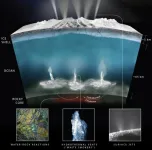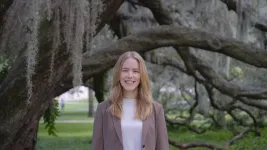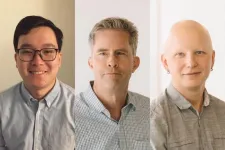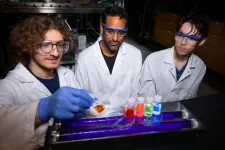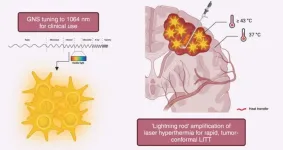Navigating the labyrinth: How AI tackles complex data sampling
2024-06-24
(Press-News.org)
The world of artificial intelligence (AI) has recently seen significant advancements in generative models, a type of machine-learning algorithms that “learn” patterns from set of data in order to generate new, similar sets of data. Generative models are often used for things like drawing images and natural language generation – a famous example are the models used to develop chatGPT.
Generative models have had remarkable success in various applications, from image and video generation to composing music and to language modeling. The problem is that we are lacking in theory, when it comes to the capabilities and limitations of generative models; understandably, this gap can seriously affect how we develop and use them down the line.
One of the main challenges has been the ability to effectively pick samples from complicated data patterns, especially given the limitations of traditional methods when dealing with the kind of high-dimensional and complex data commonly encountered in modern AI applications.
Now, a team of scientists led by Florent Krzakala and Lenka Zdeborová at EPFL has investigated the efficiency of modern neural network-based generative models. The study, now published in PNAS, compares these contemporary methods against traditional sampling techniques, focusing on a specific class of probability distributions related to spin glasses and statistical inference problems.
The researchers analyzed generative models that use neural networks in unique ways to learn data distributions and generate new data instances that mimic the original data.
The team looked at flow-based generative models, which learn from a relatively simple distribution of data and “flow” to a more complex one; diffusion-based models, which remove noise from data; and generative autoregressive neural networks, which generate sequential data by predicting each new piece based on the previously generated ones.
The researchers employed a theoretical framework to analyze the performance of the models in sampling from known probability distributions. This involved mapping the sampling process of these neural network methods to a Bayes optimal denoising problem – essentially, they compared how each model generates data by likening it to a problem of removing noise from information.
The scientists drew inspiration from the complex world of spin glasses, materials with intriguing magnetic behavior, to analyze modern data generation techniques. This allowed them to explore how neural network-based generative models navigate the intricate landscapes of data.
The approach allowed them to study the nuanced capabilities and limitations of the generative models against more traditional algorithms like Monte Carlo Markov Chains (algorithms used to generate samples from complex probability distributions) and Langevin Dynamics (a technique for sampling from complex distributions by simulating the motion of particles under thermal fluctuations).
The study revealed that modern diffusion-based methods may face challenges in sampling due to a first-order phase transition in the algorithm’s denoising path. What this means is that they can run into problems because of sudden change in how they remove noise from the data they're working with. Despite identifying regions where traditional methods outperform, the research also highlighted scenarios where neural network-based models exhibit superior efficiency.
This nuanced understanding offers a balanced perspective on the strengths and limitations of both traditional and contemporary sampling methods. The research is a guide to more robust and efficient generative models in AI; by providing a clearer theoretical foundation, it can help develop next-generation neural networks capable of handling complex data generation tasks with unprecedented efficiency and accuracy.
Reference
Davide Ghio, Yatin Dandi, Florent Krzakala, Lenka Zdeborovà. Sampling with flows, diffusion and autoregressive neural networks: A spin-glass perspective. PNAS 24 June 2024. DOI: 10.1073/pnas.2311810121
END
ELSE PRESS RELEASES FROM THIS DATE:
2024-06-24
We’ve all seen the surreal footage in nature documentaries showing hydrothermal vents on the frigid ocean floor—bellowing black plumes of super-hot water—and the life forms that cling to them. Now, a new study by UC Santa Cruz researchers suggests that lower-temperature vents, which are common across Earth's seafloor, may help to create life-supporting conditions on "ocean worlds" in our solar system.
Ocean worlds are planets and moons that have—or had in the past—a liquid ocean, often under an icy shell or within their rocky interior. In Earth's solar system, several of Jupiter's and Saturn's moons are ocean worlds, and ...
2024-06-24
Media Contact:
John Dudley
(814) 490-3290 (cell)
jjdudley@usf.edu
TAMPA, Fla. (June 24, 2024) – Mindfulness – focusing on the present moment – can improve sleep, reduce stress and improve overall health. A new University of South Florida-led study helps explain why.
Researchers studied 144 nurses over two weeks to see how well they could stay focused on the present and how often they fixated on negative thoughts. The nurses completed surveys three times a day and reported their sleep quality the following morning.
The findings shed light on how mindfulness relates to emotion ...
2024-06-24
The first issue of JACC, the flagship journal of the American College of Cardiology, under new Editor-in-Chief Harlan M. Krumholz, MD, SM, FACC, publishes today, ushering in a new era of one of the world’s leading scholarly journals.
“I envision JACC, with all its strengths, as a transformative platform for building community, elevating strong science, influencing clinical practice, supporting career development, and improving patient outcomes.” Krumholz said in his Editor’s Page. “JACC and its group of journals can play a pivotal role in serving our community and shaping the future.”
Under his editorship, JACC will be guided by ...
2024-06-24
Using an instrument on the 4.1-meter Southern Astrophysical Research Telescope, researchers obtained the first astronomical spectrum using skipper charge-coupled devices (CCDs).
The results were presented on June 16 at the Society of Photo-Optical Instrumentation Engineers Astronomical Telescopes + Instrumentation meeting in Japan by Edgar Marrufo Villalpando, a physics PhD candidate at the University of Chicago and a Fermilab DOE Graduate Instrumentation Research Award Fellow.
“This is a major milestone for skipper-CCD technology,” said Alex Drlica-Wagner, a cosmologist at the U.S. Department of Energy’s Fermi ...
2024-06-24
Researchers at the University of Toronto have harnessed a bacterial immune defense system, known as CRISPR, to efficiently and precisely control the process of RNA splicing.
The technology opens the door to new applications, including systematically interrogating the functions of parts of genes and correcting splicing deficiencies that underlie numerous diseases and disorders.
“Almost all human genes produce RNA transcripts that undergo the process of splicing, whereby coding segments, called exons, are joined together and non-coding segments, called introns, are removed and typically degraded,” said Jack Daiyang Li, first author on the study and PhD student ...
2024-06-24
Oak Brook, IL – The Society for Laboratory Automation and Screening (SLAS) will launch NexusXp, its new interactive pavilion at SLAS2025 to showcase collaborative and integrated lab automation scenarios. NexusXp combines Nexus, the Latin word for link or connection where multiple elements meet, with the modern “Xp” to signify the “Xperience” of making that critical link or connection. Through this new pavilion, SLAS will demonstrate how automation integration transforms research and enables scientific breakthroughs.
“NexusXp is an exclusive event or attendee ...
2024-06-24
AMES, Iowa – A Google Cloud video takes you inside a company data center in
southwest Iowa’s Council Bluffs.
There you are, in the middle of a long, industrial corridor. You slowly move past rack after rack after rack of the computer servers that are, Google says, “helping to keep the internet humming 24/7.”
Part of that hum is the power that keeps those data centers up and running.
“Think about when you use your computer,” said Matthew ...
2024-06-24
LAWRENCE — Many people are familiar with oncogenes — genes long known to be involved in cancers in humans, such as the gene “Src.”
What’s less widely understood is that oncogenes didn’t evolve just to cause cancer in species, but rather to control events of normal growth and differentiation.
“As an organism grows from a single fertilized egg to form all the different tissue types, these oncogenes, including Src, evolved to control these normal events,” said Erik Lundquist, professor of molecular ...
2024-06-24
“Gold nanostars amplify brain-tumor selective laser interstitial thermal therapy.”
BUFFALO, NY- June 24, 2024 – A new editorial paper was published in Oncotarget's Volume 15 on June 14, 2024, entitled, “Leveraging gold nanostars for precision laser interstitial thermal therapy.”
In this new editorial, researchers Aden P. Haskell-Mendoza, Ethan S. Srinivasan, Tuan Vo-Dinh and Peter E. Fecci from Duke University discuss laser interstitial thermal therapy (LITT). Over the past decade, LITT has become an important tool for the neurosurgical treatment of a variety of intracranial pathologies, including focal epilepsies, vascular malformations, and ...
2024-06-24
A new peer-reviewed study from researchers at The University of Texas at Arlington; the University of Nevada, Reno; Mokwon University in Daejeon, Korea; and Texas A&M University at Corpus Christi shows the Deepwater Horizon (DWH) oil spill of 2010 affected wildlife and their habitat much more than previously understood.
“Overall, we found the area of deep-sea floor affected by the DWH spill was significantly larger than previously thought,” said Masoud Rostami, an author of the study and assistant ...
LAST 30 PRESS RELEASES:
[Press-News.org] Navigating the labyrinth: How AI tackles complex data sampling
